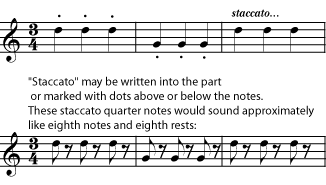| << Chapter < Page | Chapter >> Page > |
The word articulation generally refers to how the pieces of something are joined together; for example, how bones are connected to make a skeleton or syllables are connected to make a word. Articulation depends on what is happening at the beginning and end of each segment, as well as in between the segments.
In music, the segments are the individual notes of a line in the music. This could be the melodic line, the bass line, or a part of the harmony . The line might be performed by any musician or group of musicians: a singer, for example, or a bassoonist, a violin section, or a trumpet and saxophone together. In any case, it is a string of notes that follow one after the other and that belong together in the music.The articulation is what happens in between the notes. The attack - the beginning of a note - and the amount of space in between the notes are particularly important.
Descriptions of how each articulation is done cannot be given here, because they depend too much on the particular instrument that is making the music. In other words, the technique that a violin player uses to slur notes will be completely different from the technique used by a trumpet player, and a pianist and a vocalist will do different things to make a melody sound legato. In fact, the violinist will have some articulations available (such as pizzicato , or "plucked") that a trumpet player will never see.
So if you are wondering how to play slurs on your guitar or staccato on your clarinet, ask your music teacher or director. What you will find here is a short list of the most common articulations: their names, what they look like when notated, and a vague description of how they sound. The descriptions have to be vague, because articulation, besides depending on the instrument, also depends on the style of the music. Exactly how much space there should be between staccato eighth notes, for example, depends on tempo as well as on whether you're playing Rossini or Sousa. To give you some idea of the difference that articulation makes, though, here are audio examples of a violin playing a legato and a staccato passage. (For more audio examples of violin articulations, please see Common Violin Terminology .)
Staccato notes are short, with plenty of space between them. Please note that this doesn't mean that the tempo or rhythm goes any faster. The tempo and rhythm are not affected by articulations; the staccato notes sound shorter than written only because of the extra space between them.

Legato is the opposite of staccato. The notes are very connected; there is no space between the notes at all. There is, however, still some sort of articulation that causes a slight but definite break between the notes (for example, the violin player's bow changes direction, the guitar player plucks the string again, or the wind player uses the tongue to interrupt the stream of air).


Notification Switch
Would you like to follow the 'Reading music: common notation' conversation and receive update notifications?